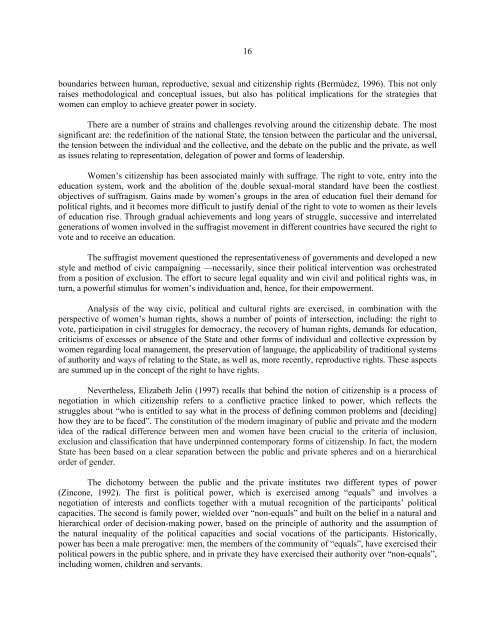Women in Latin America and the Caribbean - Cepal
Women in Latin America and the Caribbean - Cepal
Women in Latin America and the Caribbean - Cepal
Create successful ePaper yourself
Turn your PDF publications into a flip-book with our unique Google optimized e-Paper software.
16<br />
boundaries between human, reproductive, sexual <strong>and</strong> citizenship rights (Bermúdez, 1996). This not only<br />
raises methodological <strong>and</strong> conceptual issues, but also has political implications for <strong>the</strong> strategies that<br />
women can employ to achieve greater power <strong>in</strong> society.<br />
There are a number of stra<strong>in</strong>s <strong>and</strong> challenges revolv<strong>in</strong>g around <strong>the</strong> citizenship debate. The most<br />
significant are: <strong>the</strong> redef<strong>in</strong>ition of <strong>the</strong> national State, <strong>the</strong> tension between <strong>the</strong> particular <strong>and</strong> <strong>the</strong> universal,<br />
<strong>the</strong> tension between <strong>the</strong> <strong>in</strong>dividual <strong>and</strong> <strong>the</strong> collective, <strong>and</strong> <strong>the</strong> debate on <strong>the</strong> public <strong>and</strong> <strong>the</strong> private, as well<br />
as issues relat<strong>in</strong>g to representation, delegation of power <strong>and</strong> forms of leadership.<br />
<strong>Women</strong>’s citizenship has been associated ma<strong>in</strong>ly with suffrage. The right to vote, entry <strong>in</strong>to <strong>the</strong><br />
education system, work <strong>and</strong> <strong>the</strong> abolition of <strong>the</strong> double sexual-moral st<strong>and</strong>ard have been <strong>the</strong> costliest<br />
objectives of suffragism. Ga<strong>in</strong>s made by women’s groups <strong>in</strong> <strong>the</strong> area of education fuel <strong>the</strong>ir dem<strong>and</strong> for<br />
political rights, <strong>and</strong> it becomes more difficult to justify denial of <strong>the</strong> right to vote to women as <strong>the</strong>ir levels<br />
of education rise. Through gradual achievements <strong>and</strong> long years of struggle, successive <strong>and</strong> <strong>in</strong>terrelated<br />
generations of women <strong>in</strong>volved <strong>in</strong> <strong>the</strong> suffragist movement <strong>in</strong> different countries have secured <strong>the</strong> right to<br />
vote <strong>and</strong> to receive an education.<br />
The suffragist movement questioned <strong>the</strong> representativeness of governments <strong>and</strong> developed a new<br />
style <strong>and</strong> method of civic campaign<strong>in</strong>g —necessarily, s<strong>in</strong>ce <strong>the</strong>ir political <strong>in</strong>tervention was orchestrated<br />
from a position of exclusion. The effort to secure legal equality <strong>and</strong> w<strong>in</strong> civil <strong>and</strong> political rights was, <strong>in</strong><br />
turn, a powerful stimulus for women’s <strong>in</strong>dividuation <strong>and</strong>, hence, for <strong>the</strong>ir empowerment.<br />
Analysis of <strong>the</strong> way civic, political <strong>and</strong> cultural rights are exercised, <strong>in</strong> comb<strong>in</strong>ation with <strong>the</strong><br />
perspective of women’s human rights, shows a number of po<strong>in</strong>ts of <strong>in</strong>tersection, <strong>in</strong>clud<strong>in</strong>g: <strong>the</strong> right to<br />
vote, participation <strong>in</strong> civil struggles for democracy, <strong>the</strong> recovery of human rights, dem<strong>and</strong>s for education,<br />
criticisms of excesses or absence of <strong>the</strong> State <strong>and</strong> o<strong>the</strong>r forms of <strong>in</strong>dividual <strong>and</strong> collective expression by<br />
women regard<strong>in</strong>g local management, <strong>the</strong> preservation of language, <strong>the</strong> applicability of traditional systems<br />
of authority <strong>and</strong> ways of relat<strong>in</strong>g to <strong>the</strong> State, as well as, more recently, reproductive rights. These aspects<br />
are summed up <strong>in</strong> <strong>the</strong> concept of <strong>the</strong> right to have rights.<br />
Never<strong>the</strong>less, Elizabeth Jel<strong>in</strong> (1997) recalls that beh<strong>in</strong>d <strong>the</strong> notion of citizenship is a process of<br />
negotiation <strong>in</strong> which citizenship refers to a conflictive practice l<strong>in</strong>ked to power, which reflects <strong>the</strong><br />
struggles about “who is entitled to say what <strong>in</strong> <strong>the</strong> process of def<strong>in</strong><strong>in</strong>g common problems <strong>and</strong> [decid<strong>in</strong>g]<br />
how <strong>the</strong>y are to be faced”. The constitution of <strong>the</strong> modern imag<strong>in</strong>ary of public <strong>and</strong> private <strong>and</strong> <strong>the</strong> modern<br />
idea of <strong>the</strong> radical difference between men <strong>and</strong> women have been crucial to <strong>the</strong> criteria of <strong>in</strong>clusion,<br />
exclusion <strong>and</strong> classification that have underp<strong>in</strong>ned contemporary forms of citizenship. In fact, <strong>the</strong> modern<br />
State has been based on a clear separation between <strong>the</strong> public <strong>and</strong> private spheres <strong>and</strong> on a hierarchical<br />
order of gender.<br />
The dichotomy between <strong>the</strong> public <strong>and</strong> <strong>the</strong> private <strong>in</strong>stitutes two different types of power<br />
(Z<strong>in</strong>cone, 1992). The first is political power, which is exercised among “equals” <strong>and</strong> <strong>in</strong>volves a<br />
negotiation of <strong>in</strong>terests <strong>and</strong> conflicts toge<strong>the</strong>r with a mutual recognition of <strong>the</strong> participants’ political<br />
capacities. The second is family power, wielded over “non-equals” <strong>and</strong> built on <strong>the</strong> belief <strong>in</strong> a natural <strong>and</strong><br />
hierarchical order of decision-mak<strong>in</strong>g power, based on <strong>the</strong> pr<strong>in</strong>ciple of authority <strong>and</strong> <strong>the</strong> assumption of<br />
<strong>the</strong> natural <strong>in</strong>equality of <strong>the</strong> political capacities <strong>and</strong> social vocations of <strong>the</strong> participants. Historically,<br />
power has been a male prerogative: men, <strong>the</strong> members of <strong>the</strong> community of “equals”, have exercised <strong>the</strong>ir<br />
political powers <strong>in</strong> <strong>the</strong> public sphere, <strong>and</strong> <strong>in</strong> private <strong>the</strong>y have exercised <strong>the</strong>ir authority over “non-equals”,<br />
<strong>in</strong>clud<strong>in</strong>g women, children <strong>and</strong> servants.











